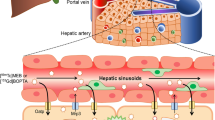Summary
An animal model for the identification and definition of toxic liver damage, based on the investigation of the BSP metabolism in the rat is proposed.
Different hepatotoxins can induce specific functional alteration on the different steps of the BSP hepatobiliary transport, mainly the uptake by hepatocytes and the biliary excretion.
Removal curves of BSP from the plasma compartment as well as the biliary secretion were evaluated in rats treated with either α-naphthylisothiocyanate (ANIT) for metabolic cholestasis, or with carbon tetrachloride (CCl4) for fatty infiltration and necrosis of the liver.
The data were compared with those obtained with untreated rats and with animals submitted either to complete or incomplete mechanically induced cholestasis.
Our results lead to the conclusion that a satisfactory discrimination among different types of liver damage may be obtained when only two plasma parameters of BSP metabolism are considered: the disappearance rate for the early 5 min (K), and 15-min plasma BSP retention (R15).
The model is proposed as a suitable tool for the evaluation of experimental hepatotoxicity in living rats giving a characterisation of the functional alteration and a measure of liver impairment.
Similar content being viewed by others
References
Becker BA, Plaa GL (1965) Quantitative and temporal delineation of various parameters of liver dysfunction due to α-naphthylisothiocyanate. Toxicol Appl Pharmacol 7:708–718
Belforte G, Molino G, Rossi G (1977) A new routine test to discriminate among subjects with different hepatic diseases. 1st Med Conf on Medical and Biological Engineering. Sorrento Proc 19:39–42
Bourdon G (1964) Etude qualitative de l'épuration sanguine de la bromesulfonephtha'eine chez le rat. Rev Internat Hépatol 14:2–10
Burdino E, Gravela E, Ugazio G, Vannini V, Calligaro A (1973) Initiation of free radical reaction and hepatotoxicity in rats poisoned with carbon tetrachloride or bromotrichloromethane. Agents Actions 4:244–253
Danni O, Brossa O, Burdino E, Milillo P, Ugazio G (1981) Toxicity of halogenated hydrocarbons in pretreated rats—An experimental model for the study of integrated permissible limits of environment poisons. Int Arch Occup Environ Health 49:165–176
Drew R, Priestly BG (1976) Drug metabolism during α-naphthylisothiocyanate-induced cholestasis. Toxicol Appl Pharmacol 35:491–499
Giorgi G, Segre G (1973) Compartmental analysis of the effect of carbon tetrachloride intoxication on blood and bile kinetics of sulfobromophthalein in rats. J Pharm Biopharm 1:217–230
Indacochea-Redmond N, Plaa GL (1971) Functional aspects of a-naphthylisothiocyanate in various species. Toxicol Appl Pharmacol 19:71–80
Javitt NB (1970) Clinical and experimental aspects of BSP and related compounds. In: Popper H, Schaffner F (eds) Progress in liver diseases III. Grune and Stratton, New York London, pp 110–117
Krebs JS, Brauer RW (1958) Metabolism of sulfobromophthalein sodium (BSP) in the rat. Am J Physiol 194:37–43
Krell H, Hoke H, Pfaff E (1982) Development of intrahepatic cholestasis by a-naphthylisothiocyanate in rats. Gastroenterology 82:507–514
Milanese M, Molino G (1975) Structural identifiability of compartmental models and pathophysiological information from the hepatic kinetics of drugs. Math Biosc 26:175–190
Molino G, Milanese M, Villa A, Cavanna A, Gaidano GP (1978) Discrimination of hepatobiliary diseases by the evaluation of bromsulfophthalein blood kinetics. J Lab Clin Med 91:396–408
Molino G, Milanese M (1975) Structural analysis of compartmental models for the hepatic kinetics of drugs. J Lab Clin Med 85:865–878
Plaa GL, Priestly BG (1977) Intrahepatic cholestasis induced by drugs and chemicals. Pharmacol Rev 28:207–273
Recknagel RO (1967) Carbon tetrachloride hepatotoxicity. Pharamcol Rev 19:145–208
Schaffner F, Sharnbeck HH, Hutterer F, Denk H, Greim HA, Poppe H (1973) Mechanisms of cholestasis-7 alpha-naphthylisothiocyanate-induced jaundice. Lab Invest 28:321–331
Ugazio G (1978) Halogenoalkanes and liver injury. In: Slater TS (ed) Biochemical mechanisms of liver injury. Academic Press, London New York, pp 709–743
Ugazio G, Kock RR, Recknagel RO (1973) Reversibility of liver damage in rat rendered resistant to CCl4 by prior CCl4 administration: bearing on the lipoperoxidation hypothesis. Exp Mol Pathol 18:281–289
Author information
Authors and Affiliations
Additional information
Supported by grants from Consiglio Nazionale delle Ricerche (Roma) and Regione Piemonte (Torino)
Rights and permissions
About this article
Cite this article
Molino, G., Cavanna, A., Biondi, A.M. et al. Bromsulphalein (BSP) kinetics in the rat: A new approach in evaluating experimental hepatotoxicity. Int. Arch Occup Environ Heath 51, 73–79 (1982). https://doi.org/10.1007/BF00378412
Received:
Accepted:
Issue Date:
DOI: https://doi.org/10.1007/BF00378412




